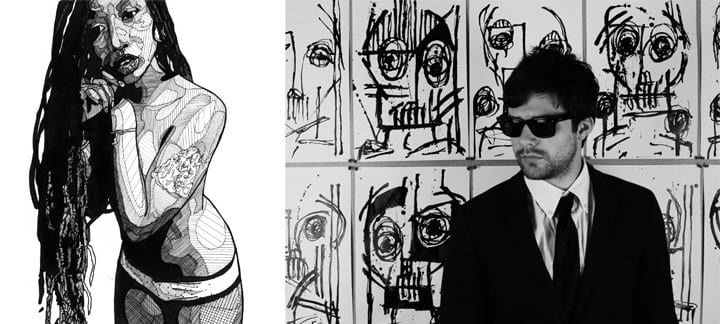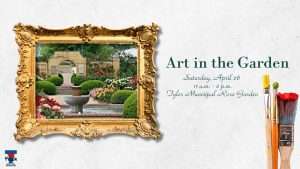“Disappear here,” is a line from a Bret Easton Ellis book “Less Than Zero.” For some unknown reason, when I think of regional artist and photographer Adam Douglas, I am reminded of “Less Than Zero” (the book not the movie). Maybe it’s because I first read it when I was 18, maybe it’s the book’s youthful, moody disillusionment, or maybe it’s just the Ray-Ban sunglasses. Ellis’ novels can be dark, to put it mildly. Sometimes I’ve been afraid to turn the page, but there is often a fierce, honest defenselessness revealed in his work as well. Twenty-five-year-old Adam Douglas describes himself as, “a trans/pansexual, freelance photographer, professional artist, mental health advocate, writer, technical guru, and an old people chauffeur.” I remember Adam as an art student at Tyler Junior College 2009-2010 as an intelligent, reserved, talented, well-liked, and dedicated student. Adam was active and outwardly relaxed in the art department and then suddenly he seemingly disappeared.
“I don’t want to care. If I care about things, it’ll just be worse; it’ll just be another thing to worry about. It’s less painful if I don’t care.” – Bret Easton Ellis, “Less Than Zero”
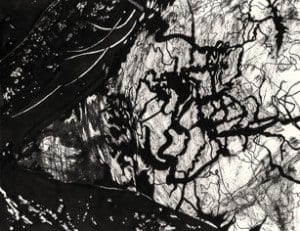 Although Adam has become somewhat reclusive and has been dealing with some personal mental health issues, he has maintained a prolific output of both photography and drawings over the years. When asked what he has been doing artistically, he states, “Lately, I’ve been working on a woodcut (relief printmaking), and experimenting with that process. This year has been riddled with different experiments though, and lots of them have been drawings, illustrations or writing.” I personally believe in the healing power of the arts. It’s not only one of the reason why I make it, but also one of the reasons why I teach it. Some artists cope with their personal challenges through the therapeutic creation of art.
Although Adam has become somewhat reclusive and has been dealing with some personal mental health issues, he has maintained a prolific output of both photography and drawings over the years. When asked what he has been doing artistically, he states, “Lately, I’ve been working on a woodcut (relief printmaking), and experimenting with that process. This year has been riddled with different experiments though, and lots of them have been drawings, illustrations or writing.” I personally believe in the healing power of the arts. It’s not only one of the reason why I make it, but also one of the reasons why I teach it. Some artists cope with their personal challenges through the therapeutic creation of art.
The website: Healing Through The Arts (www.htta.org) states, “The processes of creating art, as well as the finished piece, help make sense of people’s physical, mental or emotional needs. Healing is also possible for those who experience the art through observation and contemplation of the message. It shows us that we are not alone in our challenges.” Examples from the Healing Through The Arts website include: Vincent van Gogh (1853-1890) is one of the most famous artists who struggled with mental issues. His bouts of instability did not prevent him from creating in his highly expressive artistic language. Auguste Renoir (1841-1919), impressionist painter, suffered from severe rheumatoid arthritis during the final decades of his life. He became unable to hold a paintbrush but using art as a coping mechanism, he had a paintbrush tied to his wrist. Henry Matisse (1869-1954) was one of the greatest painters of the twentieth century, but in the last years of his life he created a new style of art in paper cutouts because scissors had become an easier tool. Frida Kahlo (1907-1954) suffered from childhood polio and also a traffic accident that left her in constant lifelong pain. Her famous series of self-portraits enabled her to objectify her physical sufferings, as well as the emotional turmoil resulting from her turbulent marriage to painter Diego Rivera.
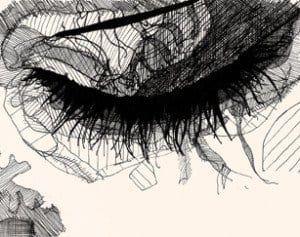 Keith Haring (1958-1990) had already achieved success with his personal caricatures before he was diagnosed with AIDS in 1988. He continued to use his art to raise awareness of AIDS and other social issues. In an interview in 1988, he said, “Part of the reason I am not having trouble facing the reality of death is that it’s not a limitation, in any way. It could have happened at any time, and it is going to happen sometime. If you live your life according to that, death is irrelevant. Everything I am doing right now is exactly what I want to do.”
Keith Haring (1958-1990) had already achieved success with his personal caricatures before he was diagnosed with AIDS in 1988. He continued to use his art to raise awareness of AIDS and other social issues. In an interview in 1988, he said, “Part of the reason I am not having trouble facing the reality of death is that it’s not a limitation, in any way. It could have happened at any time, and it is going to happen sometime. If you live your life according to that, death is irrelevant. Everything I am doing right now is exactly what I want to do.”
These themes of pain and suffering as well as resilience resonate in the work and inspiration of Adam Douglas’ artwork. I asked what inspired him to become an artist and he said, “I was a lonely, isolated, bullied, quiet, shy teenager fresh into puberty, and I had no friends. Art was there. Art has a way of doing that, being there. Art gives us a human connection of experiencing something familiar even when it’s created by a stranger or someone centuries ago or a half a world away. It still has the ability to make one think and understand the sensation, the experience, the emotion.” Adam talked about what importance art has brought to his life and he says, “Partial sanity. Drawing and writing and taking pictures and doing all of these things that I do help me through my mental issues and my problems at each particular moment in time.”
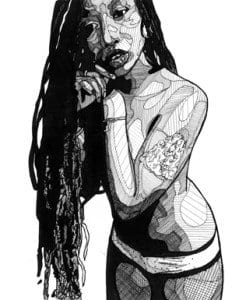 Douglas also shares that the frustrating part of being an artist is “The feeling of being hidden and ignored. But that is also a good thing too because then I can do exactly what I want to do. I can work on whatever ideas I have and I’ll think that it’s the best thing in the world and then I realize I’m just a miniscule speck on the surface of this planet.”
Douglas also shares that the frustrating part of being an artist is “The feeling of being hidden and ignored. But that is also a good thing too because then I can do exactly what I want to do. I can work on whatever ideas I have and I’ll think that it’s the best thing in the world and then I realize I’m just a miniscule speck on the surface of this planet.”
Adam is much more than an infinitesimal speck. His artwork is very powerful and reflects a compulsive dedication in the quality of his gestural line work and his talent of capturing naturalism. One can appreciate the amount of time some of his line drawings must take, as well as identify with the forms and strong, powerful possibilities in interpretations. Adam has amazing compositional skills in the way he photographs his subjects. Adam Douglas is creating quality artwork right here in East Texas that is personal and quotidian to his own life and struggles, but powerful and capable of being a reflection of our lives and struggles.
To quote a conversation between two of the characters in the “Less Than Zero” novel, “But this road doesn’t go anywhere,” I told him.
“That doesn’t matter.”
“What does?” I asked, after a little while.
“Just that we’re on it, dude,” he said.”
Adam’s art is influenced by researching German woodcuts, René Magritte (surrealist painter), Egon Schiele (Austrian, elongated figurative painter) and Stanley Donwood (pen name of English artist and writer Dan Rickwood known for his close association with
the British rock band Radiohead).
To discover and see more of Adam’s work visit: www.adamdouglasarts.tumblr.com.


